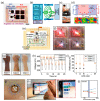Smart Sensor Systems for Wearable Electronic Devices
- PMID: 30970981
- PMCID: PMC6418677
- DOI: 10.3390/polym9080303
Smart Sensor Systems for Wearable Electronic Devices
Abstract
Wearable human interaction devices are technologies with various applications for improving human comfort, convenience and security and for monitoring health conditions. Healthcare monitoring includes caring for the welfare of every person, which includes early diagnosis of diseases, real-time monitoring of the effects of treatment, therapy, and the general monitoring of the conditions of people's health. As a result, wearable electronic devices are receiving greater attention because of their facile interaction with the human body, such as monitoring heart rate, wrist pulse, motion, blood pressure, intraocular pressure, and other health-related conditions. In this paper, various smart sensors and wireless systems are reviewed, the current state of research related to such systems is reported, and their detection mechanisms are compared. Our focus was limited to wearable and attachable sensors. Section 1 presents the various smart sensors. In Section 2, we describe multiplexed sensors that can monitor several physiological signals simultaneously. Section 3 provides a discussion about short-range wireless systems including bluetooth, near field communication (NFC), and resonance antenna systems for wearable electronic devices.
Keywords: healthcare; smart sensor; stretchable electronics; wearable electronics; wireless sensor.
Conflict of interest statement
The authors declare no conflict of interest.
Figures











References
-
- Dagdeviren C., Su Y., Joe P., Yona R., Liu Y., Kim Y.-S., Huang Y., Damadoran A.R., Xia J., Martin L.W., et al. Conformable amplified lead zirconate titanate sensors with enhanced piezoelectric response for cutaneous pressure monitoring. Nat. Commun. 2014;5:4496. doi: 10.1038/ncomms5496. - DOI - PubMed
-
- Pang C., Lee C., Suh K.-Y. Recent advances in flexible sensors for wearable and implantable devices. J. Appl. Polym. Sci. 2013;130:1429–1441. doi: 10.1002/app.39461. - DOI
Publication types
LinkOut - more resources
Full Text Sources
Other Literature Sources
Research Materials

